 Needs Pictures: 0
Needs Pictures: 0
Results 1 to 15 of 21
Thread: Bauhinia Cunninghamii
-
4th September 2021, 11:40 PM #1
 Senior Member
Senior Member











- Join Date
- Aug 2021
- Location
- Top End
- Age
- 48
- Posts
- 132
 Bauhinia Cunninghamii
Bauhinia Cunninghamii
Has anyone worked with this timber?
Also known as Bohemia, Red Bauhinia, Kimberley Bauhinia, Beantree and Jigal
It is in the Fabaceae family and very dense and heavy

I found this 55 year old tree last month. Sadly, it burnt down in a fire just a few months ago. I estimate about 1.5m of its trunk had been incinerated.
Cutting into the canopy end of the main trunk revealed a good looking grain.
Rather than letting it go to waste and completely turn to ash in the next fire I took a branch home to see how it would turn.
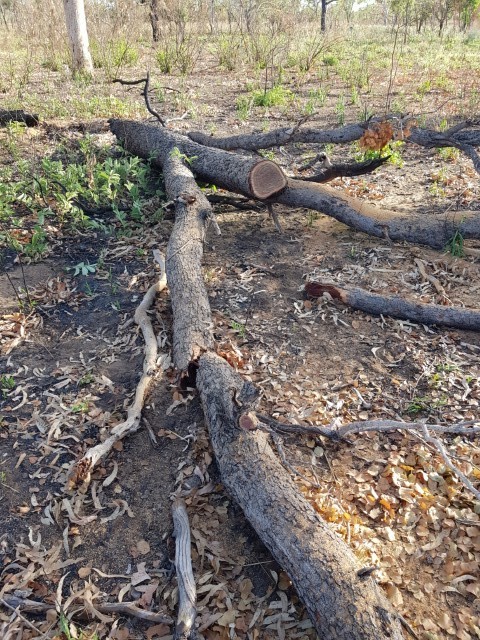
This is a young tree within 5m of the fallen tree.
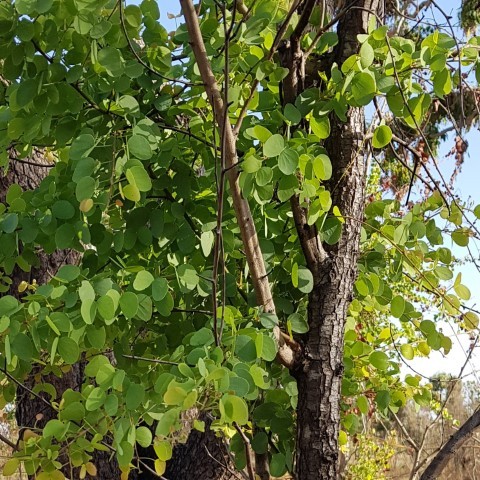
The leaves are distinct in that they face opposite directions.
I turned a 150mm branch as a test
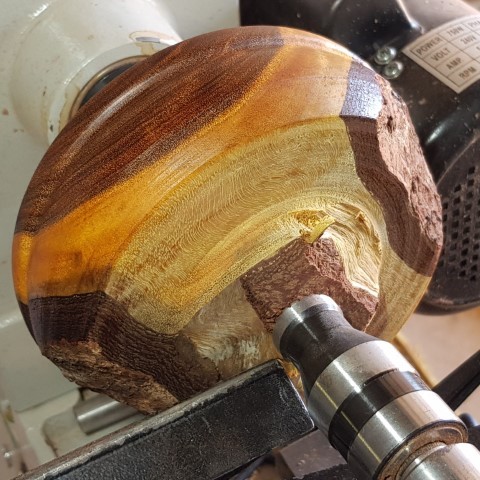
The sap wood was still quite wet and broke up while I turned a tenon. I had of course left too much bark on the base and caught an edge ripping the tenon off.
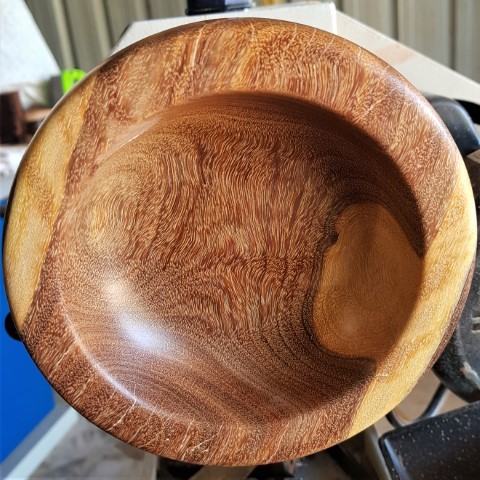
Micro cracking evident after sanding. Probably need to discard some heartwood but cant bring myself to wasting it.
No wax or finish required to get a reasonable lustre to this timber.
The heart wood is hard and rather similar to Cooktown Ironwood. Not surprising being in the same family I suppose. A bit easier to turn than Ironwood but it is no where near dry yet.
I am yet to calculate its density but should have time to do so in the next few days.
The bark holds firmly but did require some CA glue to fill fine gaps between the sapwood on the rim of this bowl. It may well fail and fall off when dry.
Anyone with any experience or knowledge of working with the timber is welcome to offer any tips, in particular drying and seasoning.
-
4th September 2021 11:40 PM # ADSGoogle Adsense Advertisement
- Join Date
- Always
- Location
- Advertising world
- Age
- 2010
- Posts
- Many
-
5th September 2021, 08:39 AM #2
 SENIOR MEMBER
SENIOR MEMBER











- Join Date
- Apr 2021
- Location
- North Qld
- Age
- 61
- Posts
- 681

Bit late like raintree imo
Very pretty grain indeed
Thanks for sharing
Log Dog
-
5th September 2021, 09:59 AM #3
 Senior Member
Senior Member











- Join Date
- Aug 2021
- Location
- Top End
- Age
- 48
- Posts
- 132

Hi LD. When you say a bit late like raintree do you mean it is a bit late to harvest the timber after it had fallen or that it looks like raintree?
-
5th September 2021, 10:07 AM #4
 SENIOR MEMBER
SENIOR MEMBER











- Join Date
- Apr 2021
- Location
- North Qld
- Age
- 61
- Posts
- 681
-
5th September 2021, 11:26 AM #5
 Senior Member
Senior Member











- Join Date
- Aug 2021
- Location
- Top End
- Age
- 48
- Posts
- 132

No worries. Thanks for the clarification LD.
The heat has cranked up in the last few weeks for sure. Other than the burnt base of the trunk there was no cracking and still very moist. I'm hoping I got to this early enough.
Yes, thats just a little mini boss


The trunk is around 400mm. The little saws bar not quite long enough to cut through without changing sides on a few cuts. The piece at the ramp was 68kg. I had to cut the foreground log up to load on the tray which ended up being around 2 x 50kg
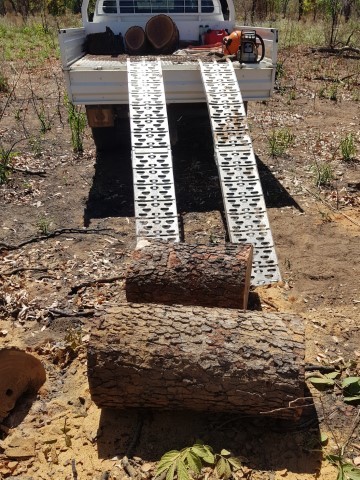
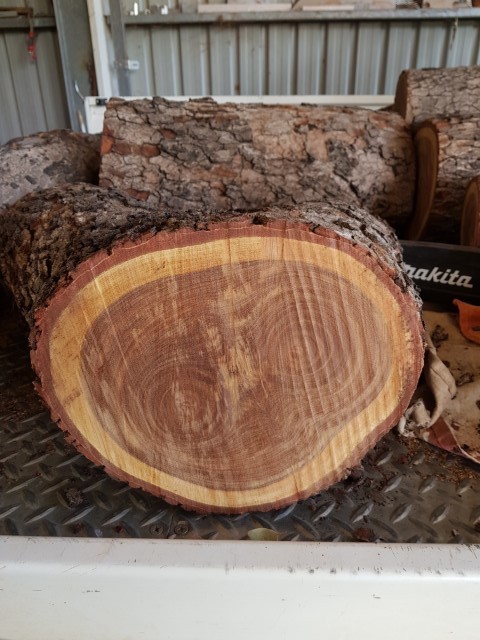
I ran out of check wax. Found YT clips of people using Titebond III to seal endgrain. A bit expensive but its much less sticky to handle than the liquid wax and is totally transparent. So far after 2 weeks no visible cracks.
Selleys aquadhere worked just as well but bubbled a bit as it dried. Doesnt seem to have made any appreciable difference. Will continue to monitor
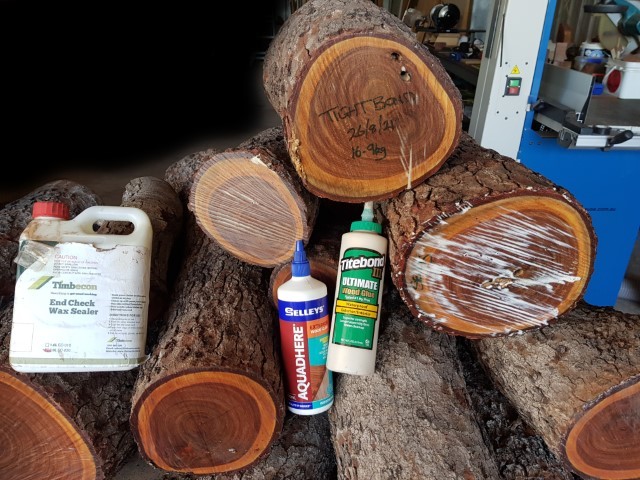
20210905_073031.jpg
Just over 400kg of large and and 300kg smalls
I have this in the SW corner of the shed. Hoping it wasnt a wasted effort and it dries okay. Its nice and cool this morning but does get hot in there.
Humidity is starting to ramp up to 80% over night down to 30% during day.
Wont be long until humidity will be 99% to 70%
Any point covering or lifting smalls off the floor?
-
6th September 2021, 09:41 AM #6

Any chance this is also a candidate for your other mystery wood?
Mobyturns
In An Instant Your Life CanChange Forever
-
7th September 2021, 12:24 AM #7
 Senior Member
Senior Member











- Join Date
- Aug 2021
- Location
- Top End
- Age
- 48
- Posts
- 132

That's a completely reasonable question Moby and has me thinking
I have found no information that this species of Bauhinia is used for timber.
(However other Bauhinia species have been used for turning.)
The grain looks similar to Cooktown Ironwood
It can be polished just by burnishing or with 400 sandpaper
Its heavy like ironwood
I weighed a 100mm wet cube at 1390g today - I might have to microwave this
On the other hand, there are no other ironwood trees anywhere near where this tree had burnt down. No lignotubers of ironwood near by. Every other burnt Ironwood I have come across has new growth from these
The sapwood and the bark are different. There are no horns on the back of the bark
It smells different
I did take a sample of the dried leaves which matched the "mother inlaw" (looking opposite directions) morphology but I will return to the crown of the tree to look again at the leaf formation.
I could only find some random unreferenced UK claim that this species is the heaviest in the world.
See fact 9. https://www.factory-direct-flooring.co.uk/advice-centre/facts-about-wood
I couldnt find anything to support this
Synonyms
Lysiphyllum cunninghamii (Benth.) de Wit, Reinwardtia 3 : 431(1956). Bauhinia cunninghamii (Benth.) Benth. f. cunninghamii, Queensland Agricultural Journal 25(6): 287(1910). Phanera cunninghamii Benth., Plantae Junghuhnianae enumeratio plantarum : 264(1852), Type: In Australia tropica ad Careening-Bay (Cunningham). Bauhinia hookeri var. broomensis Hochr., Candollea : 383(1925), Type: Australie, cote N.W., Broome, 4 fevrier 1905, arbre ou arbuste de 4-8 m., commun dans le bush et dans la ville (n. 2850). Bauhinia leichhardtii F.Muell., Transactions of the Philosophical Institute of Victoria 3: 50(1859), Type: Not rare in Arnhems Land and around the Gulf of Carpentaria. Bauhinia leichhardtii F.Muell. var. leichhardtii, Mr. Winnecke's Explorations During 1883 : 15(1884).
-
7th September 2021, 08:38 AM #8

"There are no horns on the back of the bark"
I'm not convinced that "horns," i.e. epicormic buds, are a reliable ID key for some woods. Research that I have read suggests that their presence in trees are potentially linked to hormone/s and/or environmental factors. The epicormic buds are or can be "more abundant on the warmer or more exposed sides of trees" - "occur most frequently on the least vigorous trees" "tend to be present on the upper bohle."
Given those observations and that the feature could well be more pronounced in populations that have been exposed to a hot fire and not present in others that have not experienced a fire seems to me to be a quite variable ID key.Mobyturns
In An Instant Your Life CanChange Forever
-
7th September 2021, 09:32 PM #9
 GOLD MEMBER
GOLD MEMBER











- Join Date
- Apr 2015
- Location
- Warragul Vic
- Posts
- 1,093

Here are a few general views and comments. I believe it a Bauhinia as you have suggested. Hope this is helpful. It may not be what you want.
I have cut and used this species for reference samples. It is good for turning imo though I am not a turner.
Bauhinias all have distinctive leaves and flowers. Leaves in paired leaflets like butterflies, (Lysiphyllum is new genus name.)
Woods are very hard and dense. The Red Bauhinia (B. carronnii,) Carrons Buahinia has sweet nectar in its flowers and wood a small black heartwood wood. Its called ebony for that reason ocassionally. B hookeri also has a small dark heartwood. Both are good turning woods when dried I believe (Neil?). I would cut some billets in half lengthwise to allow better drying and radial movement as it dries. Your end coating should be fine and high humidity will slow drying down (good). The other species can be turned too but have paler heartwood (like yours shown). Just my experience with some of these.
I may be able to provide more data later f you want. Neil can provide more data I'm sure.
Eug
-
7th September 2021, 09:44 PM #10
 Senior Member
Senior Member











- Join Date
- Aug 2021
- Location
- Top End
- Age
- 48
- Posts
- 132

Thats fascinating that so many factors come to play. Thanks for the research and posting Moby.
You were right to question if this was another ironwood. I went back to the tree and took a long careful look at the dead leaves after which determined were most certainly not Bauhinia.
So what did I learn?
Dont fixate on trees that are in close proximity
Just because this tree had no other trees of the same species around doesnt mean that the species should be quickly disqualified.
Wet timber is different
Allow for variability
If it looks like a duck and quacks like a duck it probably is.
Oh - one more. Dont start a thread on a misguided inexperienced notion
Mods - feel free to rename this thread to whatever maybe more appropriate
-
7th September 2021, 09:52 PM #11
 Senior Member
Senior Member











- Join Date
- Aug 2021
- Location
- Top End
- Age
- 48
- Posts
- 132

Thanks for the information Eug.
As you can see I have looked closely at the remaining leaves today confirming this tree is an Ironwood.
I am however keen to learn more about Bauhinias.
Thanks for the seasoning tips. I am waiting for more check wax to arrive so I can process further.
Much appreciated
-
8th September 2021, 09:38 AM #12

Powderpost & I have been discussing the ID of a "Euc" on his property, on and off for a while now, and are yet to reach agreement on a reliable ID for the "Red Mahogany."
Given that there are some 700+ known "Eucs" and that they are also known to hybridize we may never know - and that is having both the multi stemmed living tree still standing and wood from one fallen stem, plus we are amateurs.
On a few occasions I have taken the opportunity to do a walk over with a botanist engaged by my then employer to complete a botanical survey to comply with environmental legislation for various projects. It is a real eye opener to observe how they use dichotomous keys to logically assess the specimens attributes to arrive at a "reliable" ID for the less common species. Mostly the botanist has an area of speciality and can quickly visually assess many specimens with a high degree of certainty, then they love the challenge of the "curly ones." (same applies with cultural heritage surveys.)
In Australia we are blessed with some valuable tools created by researchers that aid in tree ID plus we also have quite extensive vegetation mapping that identifies "plant communities" - species commonly found together in association with various soil types, environmental conditions, micro-climates etc and broadly classified as littoral, wet / dry savannah, etc. Well worth seeking out if you have a specific interest in tree botany.
There will always be outliers - like finding a bush lemon / orange / mandarin in seemingly "virgin" country. Humans and numerous other native animals particularly "flying foxes" spread seeds for various reasons, some are a natural part of the environmental "chain" of conservation. Some of the "introduced species" are so glaringly obvious but others quite subtle to detect. Humans are the ones who place "labels" on things - like the quite amusing debate between Cook Shire and NPWS a few years back over "Coconuts" are they endemic or introduced? NPWS seemed to prefer the "introduced" line and were removing them.Mobyturns
In An Instant Your Life CanChange Forever
-
8th September 2021, 05:32 PM #13

Hi FW, the timber and bark do not look like Red Bauhinia, the Red Bauhinia (Lysiphyllum carronii) has a thick sapwood and a relatively small dark hardwood. It looks more like White Bauhinia (Lysiphyllum hookeri). I scored a heap of White Bauhinia when on a IWCS trip back a few years back and gave some to Eugene. Definitely hard and heavy, another reason it has yet another common name of Qld Ebony. I haven't turned any as yet.
Best info on the Bauhinias in FNQ is in TTIT's site ttit - Trees & Turnings. He has detailed information and turnings from both the Red and White, plus a lot of other speciesNeil____________________________________________Every day presents an opportunity to learn something new
-
8th September 2021, 11:30 PM #14
 Senior Member
Senior Member











- Join Date
- Aug 2021
- Location
- Top End
- Age
- 48
- Posts
- 132

Now thats something to consider. Hybridization would certainly add to the ID difficulty let alone all the environmental factors.
A couple months ago I downloaded an App called Euclid to help id Eucalypts, Corymbia and Angophora. Indeed, so many species and variation.
Of course, this app didnt help id Fabaceae species.
Thanks for sharing your story Moby. I am somewhat heartened that even those that have worked with timber for many years can get caught up with identification.
Hi Dai Sensei.
Thanks for the link. I checked out TTIT about a month ago and found it a great resource.
If you have any pics of white Bauhinia I'd be keen to see
Cheers
-
9th September 2021, 10:55 AM #15

Unfortunately I put my White Bauhinia in a steel drum of water to cure slowly whilst I was away for 13 moths travelling. The water went acidic and reacted with the steel drum effectively making Black Jack and turned all the blanks completely black. The heartwood was already pretty black but even the nice white sapwood turned black. I then experimented with some bleaching compounds, they are all waiting to pass through a thicknesser to repair/return to original colours. The photos I took when the logs were harvested were also lost due to my mobile phone I had at the time dying.
Neil____________________________________________Every day presents an opportunity to learn something new
Similar Threads
-
Bauhinia Bowl
By Big A in forum WOODTURNING - GENERALReplies: 2Last Post: 11th April 2019, 07:00 PM -
Allocasuarina Cunninghamii
By Luke Maddux in forum TIMBERReplies: 6Last Post: 5th May 2015, 12:27 AM



 Thanks:
Thanks:  Likes:
Likes:  Picture(s) thanks:
Picture(s) thanks: 
 Reply With Quote
Reply With Quote
